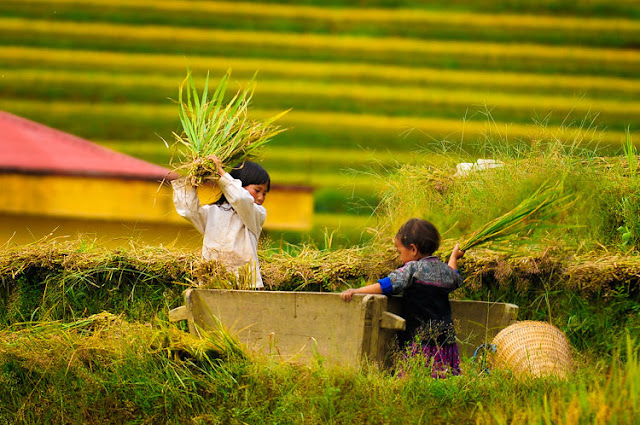MU CANG CHAI (North Vietnam): Mu Cang Chai in Vietnam’s northern highlands is a spectacular base from which to explore the country’s undiscovered rice terraces...
Mu Cang Chai is a rural district of Yen Bai Province in the Northeast region of Vietnam. With a population of nearly 45,500 for a district covering an area of 1,199 km². Mu cang Chai is on the same path to the way to Sapa. Unlike Sapa or Ha Giang, Mu Cang Chai doesn't have many things to do besides its main draw: golden terraced rice fields.Travelers do not really visit Mu Cang Chai out of its best time from September to October. Yet when the harvest season comes, everyone tries to get to Mu Cang Chai, just to have a look at the man-made wonder that the people here have diligently created over the years. In this time of every year the city turns into a paradise of rice fields around.
What to eat in Mu Cang Chai?
1. Tu Le sticky rice with chicken
Tu Le glutinous sticky rice is a famous specialty of Mu Cang Chai Vietnam. Tu Le rice is planted at Muong Lo field, famous for its special aroma. When cooked, the rice taste sweet and heavenly fragrance. Tu Le sticky rice is often eaten with grilled chicken or pork. Sesame will enhance the taste and aroma of the sticky rice even more, so a plate of roasted sesame always accompanies this dish.2. Tu Le Com (green rice)
Like the sticky rice, Com or green rice made in Tu Le is well-known to eaters across the country. The rice grains in Tu Le are big, white and almost transparent, when green rice made with the grains has a sweet taste and light fragrance. The dish requires a meticulous process of making which the locals are so dedicated and careful in each step.During the harvest season, you can find green rice sold by the locals on the roadside or in local markets and restaurants.
Five-coloured sticky rice:
The sticky rice is made from glutinous rice but the colours are made from natural ingredients. There will be five different colours including green, yellow, red, purple and white. Due to different ingredients, the fragrances of each coloured sticky rice will be different, too. You can find this dish most frequently at fair markets.
3. Tao Meo
Tao Meo or Meo apple is the common fruit in northwest Vietnam and quite well-known across the country for its health beneficial characteristics (like treating stomach pains, high blood pressure and even heart-related sicknesses). Meo apple is small, planted mostly in mountainous region and can be found in Mu Cang Chai between September and October. The apple tastes sour and lightly bitter which makes Tao Meo very special fruit to try in your trip to Mu Cang Chai.4. Salmon
Salmon fishes are available in Khau Pha restaurant which is located about 7 kilometers from Khau Pha pass on the direction to Tu Le. This restaurant has its own salmon farm with a number of more than 10000 salmon fishes which are imported from Europe and grown with European standards. There are various dishes that can be made with the salmon, if you go with a large group, you can have a big hotpot for the lunch.How to get to Mung Cang Chai?
*From Hanoi: You will need at least 2.5 days and ideally 3 days to visit Mu Cang Chai from Hanoi. Transportation means available are train, bus and motorbike:
By Train, the Hanoi – Lao Cai train will stop and drop you off at Yen Bai railway station, from there you will have to catch a bus to Mu Cang Chai for a cost of about 100,000VND.
By Bus, buses to Yen Bai or Nghia Lo are available at My Dinh and Giap Bat bus stations. At Yen Bai or Nghia Lo, take a local bus to Nghia Lo and Mu Cang Chai or Mu Cang Chai.
By motorbike, it will take you about 8 hours of riding. Therefore, you shouldn’t ride continuously. Take rest at Nghia Lo town for the first night and conquer the rest in the second day.
By Bus, buses to Yen Bai or Nghia Lo are available at My Dinh and Giap Bat bus stations. At Yen Bai or Nghia Lo, take a local bus to Nghia Lo and Mu Cang Chai or Mu Cang Chai.
By motorbike, it will take you about 8 hours of riding. Therefore, you shouldn’t ride continuously. Take rest at Nghia Lo town for the first night and conquer the rest in the second day.
*From Sapa: There are buses from Sapa to Mu Cang Chai Vietnam available and takes about 5 hours for a distance of about 160 kilometers.*Sapa – Mu Cang Chai Route:Sapa Bus station – O Quy Ho village - Thac Bac - Cau May - O Quy Ho pass - Son Binh - Huoi Ke - Muong Khoa - Tan Uyen district (Lai Chau province) - short break - Than Uyen district (Lai Chau province) - Mu Cang Chai district - Moon guest house - Mu Cang Chai bus station (last stop).









Comments
Post a Comment